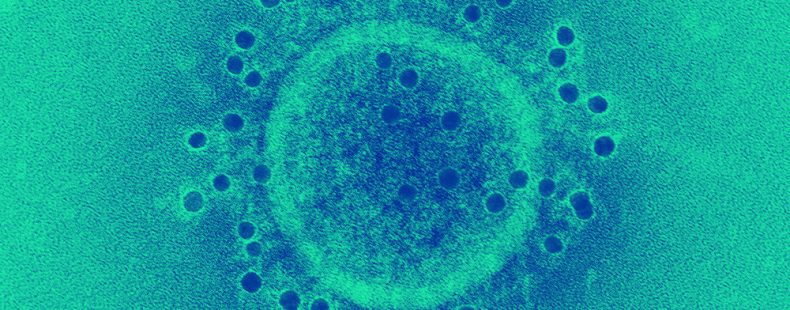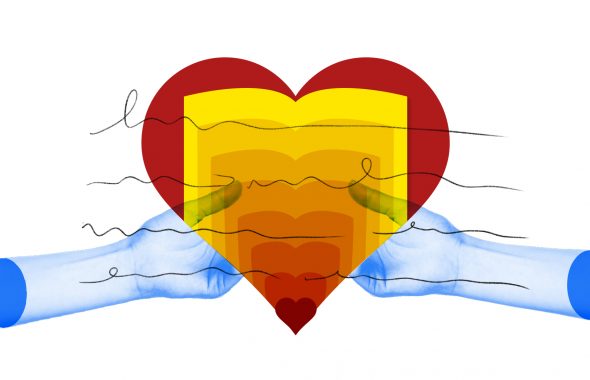Terms and concepts to understand coronavirus antibody testing
by John Kelly, Senior Research Editor at Dictionary.com
Testing continues to be a major story—and concern—amid the COVID-19 pandemic. This includes diagnostic testing to determine if one is infected with the virus that causes COVID-19. It also includes serological tests to determine if a person has antibodies that can signal immunity to COVID-19.
But what does serological mean, and what are antibodies, for that matter? As the coronavirus pandemic evolves, we know that vocabulary and concepts evolve with it. Continuing our mission to keep you informed and up-to-date, we’re providing a primer to very complicated topics, and terms, in immunology—complete with a handy glossary to all things antibodies at the end and some checkmarks (✅) to help you digest the key takeaways along the way.
What is immunity?
Before we can discuss antibodies, we need to take a big-picture look at the immune system. The immune system is an incredibly complex network of cells that identify and defend against foreign substances in your body. It includes the thymus, spleen, lymph nodes and lymph tissue, stem cells, white blood cells, antibodies, and lymphokines.
One major type of foreign substances the immune system fends off are pathogens: infectious agents, especially viruses and bacteria, that cause disease.
✅ Your body has immunity when it is resistant to a particular disease. This immunity is usually indicated by the presence of a critical part of the immune system: antibodies.
Antibodies vs. antigens
Antibodies are special protein molecules that the immune system produces in response to antigens. And antigens are substances that can stimulate the body’s production of antibodies.
Now, there are different types of antigens, but, for our purposes here, let’s zoom in on foreign, disease-causing antigens. These are harmful substances that come from outside the body, such as from viruses or bacteria.
✅ The body wants to fight antigens off, so it recognizes these substances and starts making antibodies. Antibodies are able to latch onto the antigens using a unique binding site, which then disables the invaders.
Put simply, the body makes antibodies to fend off germs and other harmful substances. And this process is part of the body’s immune response.
Learn more about this interconnected (and yes, confusing) pair of words, antibody and antigen, in our article “‘Antibiotic’ vs. ‘Abiotic’ vs. ‘Antibody’: What Is The Difference?”
How antibodies work
Antibodies are produced by B cells, also called B lymphocytes, which are made in bone marrow and found in the blood and lymph. Antibodies have a distinctive Y shape, which is key to how they work.
✅ At the tips of antibodies are the unique sites where they bind with a matching site on antigens—and destroy them.
Abbreviated as Ab, antibodies are also referred to as immunoglobulins, abbreviated as Ig. Specifically, immunoglobulins are the special proteins that function as antibodies. They are found in plasma (the liquid part of blood and lymph), other body fluids, and in the membrane of certain cells.
There are five classes of immunoglobulins, which can be described by where they are found and what their function is:
- IgA (immunoglobulin A): found in breathing and digestive passages as well as in saliva, tears, and blood, among other places; helps protect surfaces that are exposed to foreign substances from outside the body
- IgD (immunoglobulin D): found in cells in tissues in the chest and belly; function as receptors; least understood of the immunoglobulins
- IgE (immunoglobulin E): found in lung, skin, and mucous membranes; help expel parasites in the intestines and are involved in allergic reactions
- IgG (immunoglobulin G): found in all body fluids; critical to fighting infections from viruses and bacteria; only antibodies that can pass over the placenta from mother to fetus; most common but smallest antibody
- IgM (immunoglobulin M): found in blood and lymph fluid; first antibody to respond to an infection; largest antibody
IgG and IgM are two of the key players in your body when it comes to warding off infectious diseases.
What is serum?
Among other proteins, blood serum contains antibodies, which, as we saw above, indicate immunity to a specific disease. Serum is a clear, pale-yellow liquid that separates out from the clot when blood is coagulated.
✅ When antibodies are identified in the blood serum of animals with an immunity to a disease, the serum may be injected into other animals in an effort to transfer that immunity.
Word break: where does the word serum come from? Serum derives directly from the Latin serum, meaning “whey.” Blood serum was originally likened to whey, the watery liquid that is separated out from curds in the cheese-making process.
The adjective form of serum is serous—not to be confused with serious, though serum is indeed a serious matter.
What is a serological test?
Now, the combining form of serum is sero–, which appears in a number of intimidating-seeming words that frequently come up in discussions of infectious disease.
Serology (literally, “study of serum”) is the science dealing with the immunological properties and actions of serum. Its adjective is serological, and a specialist in serology is a serologist.
✅ One major job of serologists is to test serum for antibodies. A serological test, also called an antibody test, detects antibodies in the blood when the body’s immune system is responding to a specific infection.
Serological tests determine your serostatus: whether or not you have detectable antibodies against a particular antigen. Your serodiagnosis can be seropositive (your serum tests positive for detectable antibodies against the antigen) or seronegative (your serum tests negative for detectable antibodies against the specific antigen).
✅ Seropositive, in everyday terms, means you have the antibody to fend off a particular disease.
Now, when a person develops those specific antibodies when they were not previously detectable, that process is known as seroconversion. Seroconversion happens as a result of infection or immunization, which leads us to our final important distinction.
For more serological terms, see the definitions of seroprevalence, seroprotection, serosurvey, and serosurveillance from the World Health Organization included in our glossary below.
Active immunity vs. passive immunity
Quick review: your body has immunity when it is resistant to a specific disease. Now, there are two ways the body develops this all-important immunity: passive immunity and active immunity.
Passive immunity provides more temporary protection from the injection of antibodies (or certain lymphocytes) from other immune organisms. One of the most common sources of passive immunity in humans is the transfer of antibodies through the placenta to infants.
Active immunity is protection resulting from your own immune system. It is much longer lasting, and sometimes lasts for a person’s entire life—making it much more advantageous. There are two ways to gain active immunity to a specific disease:
- Surviving infection with the actual disease (natural immunity)
- Getting a vaccine of a killed or weakened form of the disease (vaccine-induced immunity)
✅ Passive immunity results from when a person is given antibodies to a disease. Active immunity results from when a person produces their own antibodies through exposure to the disease.
Both vaccines and antibiotics are used to treat infectious diseases. There are vaccines that work against both viruses and bacterias. Antibiotics, however, only work against bacteria and other microorganisms. Vaccines stimulate antibody production in the body. Antibiotics inhibit the growth of or destroy bacteria or other microorganisms.
Learn more about antibiotics in our article “‘Virus’ vs. ‘Bacteria’: What’s The Difference?”
Antibodies and coronavirus treatment
So, what does this all mean for COVID-19? Serological tests for antibodies to COVID-19 are important. As the Food and Drug Administration explains:
“Experience with other viruses suggests that individuals whose blood contains antibodies associated with SARS-CoV-2 infection—provided they are recovered and not currently infected with the virus—may be able to resume work and other daily activities in society. They may also be eligible to serve as potential donors of convalescent plasma.”
Serological tests can also greatly help the medical community understand immune response to COVID-19. But, current tests have limitations (none have been validated for diagnosing infection with COVID-19, for instance), and there are concerns about their reliability (some have yielded false positives). Furthermore, the WHO reports: “There is currently no evidence that people who have recovered from COVID-19 and have antibodies are protected from a second infection.”
For health, safety, and medical emergencies or updates on the novel coronavirus pandemic, please visit the CDC (Centers for Disease Control and Prevention) and WHO (World Health Organization). For more words related to the coronavirus, see our full glossary and our dictionary updates.
Glossary to key antibody terms
active immunity
immunity in an organism resulting from its own production of antibody or lymphocytes.
antibody
any of numerous Y-shaped protein molecules produced by B cells as a primary immune defense, each molecule and its clones having a unique binding site that can combine with the complementary site of a foreign antigen, as on a virus or bacterium, thereby disabling the antigen and signaling other immune defenses. Abbreviation: Ab
antigen
any substance that can stimulate the production of antibodies and combine specifically with them.
false positive
a test result that is incorrect because the test indicated a condition or finding that does not exist.
immunoglobulin
any of several classes of structurally related proteins that function as antibodies or receptors and are found in plasma and other body fluids and in the membrane of certain cells.
IgG
immunoglobulin G: a class of circulating antibodies predominant in serum, produced by plasma cells and memory cells in response to pathogens and other foreign substances, able to pass through the placental wall to the fetal circulation to impart immune defense for the period of infancy.
IgM
immunoglobulin M: a class of short-term circulating and secretory antibodies existing as an aggregate of five antibody molecules, having a high affinity for viruses.
passive immunity
immunity resulting from the injection of antibodies or sensitized lymphocytes from another organism or, in infants, from the transfer of antibodies through the placenta or from colostrum.
plasma
the liquid part of blood or lymph, as distinguished from the suspended elements.
serum
1. the clear, pale-yellow liquid that separates from the clot in the coagulation of blood; blood serum.
2. immune serum.
3. a serum containing naturally or artificially produced antibodies to a given antigen, obtained from human or animal sources.
serology
the science dealing with the immunological properties and actions of serum.
seroconversion
development of antibodies in blood serum as a result of infection or immunization.
seropositive
showing a significant level of serum antibodies, or other immunologic marker in the serum, indicating previous exposure to the infectious agent being tested.
seronegative
showing no significant level of serum antibodies, or other immunologic marker in the serum, that would indicate previous exposure to the infectious agent being tested.
seroprevalence
from the World Health Organization (WHO):
“proportion of people in a population who test seropositive for a specific infectious pathogen; often presented as a weighted percentage of the total number of specimens tested.”
seroprotection
from the World Health Organization (WHO):
“detection of antibody above a postulated immune-protective threshold.”
serostatus
being seropositive or seronegative for a specific antibody
serosurveillance
from the World Health Organization (WHO):
“serosurveys conducted on a periodic basis or through ongoing collection and testing of specimens to assess changes in seroprevalence over time.”
serosurvey
from the World Health Organization (WHO):
“collection and testing of serum (or proxy such as oral fluid) specimens from a sample of a defined population over a specified period of time to estimate the prevalence of antibodies against a given specific infectious pathogen as an indicator of immunity.”
vaccine
any preparation used as a preventive inoculation to confer immunity against a specific disease, usually employing an innocuous form of the disease agent, as killed or weakened bacteria or viruses, to stimulate antibody production.














